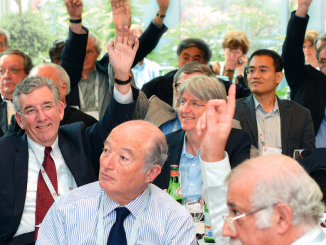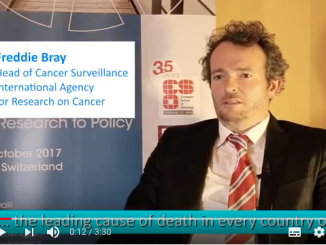Following the third UN high-level summit on non-communicable diseases last September, and with preparations for the 2019 high-level summit on Universal Health Coverage gathering speed, the World Oncology Forum (WOF) is making the case for investment in accessible cancer services to be an integral part of frameworks to improve global health.
Work kicked off last November, when a WOF taskforce, comprised of leading figures from the international cancer community and global health policy, gathered in Inveruno, Italy, under the auspices of the European School of Oncology. Their task was to develop a simple and compelling case that can challenge the assumptions of those who assert that providing treatment for people with cancer should not be a priority for developing countries.
Rifat Atun, Professor of Global Health Systems at Harvard University, and co-chair of the WOF Taskforce, said the key to success is to build an easy-to-understand, credible narrative that starts by depicting the economic and human impact of cancer, including on the world’s poorest communities. It then needs to highlight the asymmetry between that impact and the tiny proportion of global health spending currently devoted to tackling cancer. Most importantly, it needs to spell out the returns that can be expected from investing more in essential cancer services.
Finding a core set of meaningful and measurable indicators, he argued, would give confidence to policy makers and funders about the value of such investment, and also make it possible to compare progress between regions and countries and track progress.
“We just need one signature publication a year that is going to summarise all the achievements and the excellent work that is going on, and will highlight the challenges that remain,” he said.
Sania Nishtar, a co-chair of the WHO high-level commission on non-communicable diseases, set out the global health policy context by video link. She reported that the third high-level summit on NCDs, which had taken place the previous month, together with a new emphasis on strengthening healthcare systems and universal access to healthcare, represented some welcome progress in relation to cancer control.
However, failure to address the issue of access to treatment meant that, even with greater investment in early diagnosis and diagnostic technologies, poorer people across the world will continue to die of treatable cancers and their families could face financial ruin if they try pay for treatment from their own meagre funds.
“The whole discourse around the need to overcome financial access barriers to treat diseases like cancer and other expensive NCDs is missing,” said Nishtar. She emphasised the urgent need to make a strong case for investing in cancer services, in light of the 2019 high-level meeting on Universal Health Coverage.
The Taskforce agreed that credible measures of the burden of cancer are required that use transparent and consistent and internationally accepted accounting methodology that can be applied at a global, regional and national level.
Such a measure should take into account the economic impact of long-term impoverishment of families that can result from incurring catastrophic expenditure to pay for treatment.
The human cost of serious cancer-related suffering should also be measured. The taskforce heard that efforts to develop a new metric, under the working title of ‘suffering-adjusted life years’ (SALYs) could help with this. The point was made that the cancer community could learn a lot from the palliative care community about developing standardised approaches to measuring and monitoring burden and the quality of and access to services.
Measuring the amount currently invested in preventing and treating cancer was another area identified as requiring a lot more work. It was noted, for instance, that while estimates for global health development aid indicated less than 2% goes to all non-communicable diseases, there is no information about what proportion of that funding goes towards cancer. Part of the problem is that cancer comprises so many different diseases, tackled in different ways, so calculating total expenditure will require bringing together money spent under a myriad of disparate headings.
On the question of how to approach making the investment case, the Taskforce saw the methods used by the Lancet Oncology Commission on Global Access to Radiotherapy as a possible template. The authors made detailed analyses of the burden of cancers amenable to treatment by radiotherapy, of the cost of investing to meet the treatment needs, and of the clinical benefits of carrying out such treatments and the resultant economic returns.
The analysis was done separately for upper-middle income countries and lower-middle income countries, assuming current efficiency levels and greatest efficiency. They showed a six-fold return on investment was achievable within a matter of years for upper-middle income countries, with a two-fold return in lower-middle income countries.
The Taskforce agreed that it would be worth exploring the possibility of adapting that methodology for application to specific national cancer burdens and capacities, to make the economic case for investing more widely in the diagnostic and treatment services required.
The Magnitude of Clinical Benefit Scale, developed by the European Society for Medical Oncology, was seen as a valuable tool for standardising measures of clinical benefit, which would be an important element of making the investment case, and could be extended to apply to surgical and radiotherapy treatments and diagnostics as well.
Finally, the Taskforce turned its attention to strengthening the investment case by identifying ways of cutting costs by developing more efficient and innovative ways of purchasing and delivering cancer services.
Rifat Atun, who worked at the Global Fund for AIDS TB and malaria as a member of the Executive Management Team as the Director of strategy and performance, described how introducing the principles of transparency, benchmarking and pooled purchasing helped minimise prices while protecting quality and access to a variety of drugs, diagnostics and other technologies. “Evidence, we published in the BMJ last year [2017], showed that improving price, quality, consistency and probity the rough effective procurement can lead to efficiency gains of between 7% and 74%,” he said.
Other opportunities identified for doing more with less included developing standardised training protocols to equip non-medical personnel to take on many tasks that do not require full medical training, and promoting capacity building initiatives at a regional level or between regions with similar levels of resources and health service development. An Omani initiative to train cancer nurses from across the Middle East, and even some Arabic speaking African countries was cited as a good example.
Speaking from recent experience working as head of the City Cancer Challenge – a project developed by the Union for International Cancer Control – Aranda Sanchia pointed out that a key reason why so little is being invested in cancer is that no-one is making that case. “Clearly there is a massive need for money, but when we talk to the health financing people they say well we’ve never had anyone ask us. The need is not turned into a tangible ask. No one is articulating the case for cancer investment well.”
Concluding the discussion, Franco Cavalli, who has led the series of World Oncology Forums, and co-chaired the WOF taskforce, emphasised the value of piloting models for building cancer diagnosis and treatment services that can demonstrate the value of investing in cancer care, and can be adapted for use by other regional and national authorities. He cited the breast cancer project in Kyrgyzstan, which is supported by the European School of Oncology and the Swiss Cancer League, and the Chinese Academy of Medical Sciences, and more recently was adopted as a project within the ambitious Chinese ‘Belt and Road’ international development project. “We have shown that, starting practically from the scratch, it was possible to reach a high standard of diagnosis and treatment in this Euro-Asiatic republic in less than three years,” he said.





